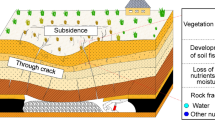Abstract
This study was carried out to determine the effect of geological environment on the biogeochemical properties of Helichrysum arenarium. Plant samples from Upper Cretaceous andesite, basalt, and their pyroclasts; Eocene andesite, basalt, and their pyroclasts; and Upper Eocene granitic rocks were collected. Roots, stems, and flowers of the plant were analyzed to determine their major and trace elements, such as Ca, Mg, Al, Na, K, Fe, Mn, U, Sr, P, La, Cr, Ba, Ti, B, W, Hg, Cs, Hf, Rb, Zr, and Ce. This study is one of the few studies in which the element content of H. arenarium is studied in detail and the element accumulation capacities are examined according to the types of rocks the plants grow. Result showed that the plants exhibited different element accumulation capacities according to the lithological environments where they grew. The element concentrations in the root, stem, and flower of the plant were predominantly high in Eocene andesite, basalt, and pyroclasts. High values were also observed in plants grown on the Upper Eocene granitic rock. Some elements were also high in plants grown in the Upper Cretaceous andesite, basalt, and pyroclasts. Therefore, the high element contents of plant are related to the element contents of the rocks where the plants grew. Furthermore, the alteration and tectonic influences on the plants are also influential.











Similar content being viewed by others
References
Damascos MA, Arribere M, Svriz M, Bran D (2008) Fruit mineral contents of six wild species of the north Andean Patagonia, Argentina. Biol Trace Elem Res 125:72–80. https://doi.org/10.1007/s12011-008-8159-y
Güner S, Yazıcı E, Dursun Ö, Akyürek S (2012) Gümüşhane-Demirören Sahasının Maden Jeolojisi Raporu. Ankara
Tabata M, Honda G, Sezik E, et al. (1993) A report on traditional medicine and medicinal plants in Turkey (1990, 1991). Kyoto University, Faculty of Pharmaceutical Sciences, Japan
Rudnick R, Gao S (2010) Composition of the continental crust. In: Holland H, Turekian K (eds) Readings of treatise on geochemistry, 2nd edn. Elsevier, London, UK
Vural A (2015a) Contamination assessment of heavy metals associated with an alteration area: Demirören Gumushane, NE Turkey. J Geol Soc India 86:215–222. https://doi.org/10.1007/s12594-015-0301-9
Vural A (2015b) Biogeochemical characteristics of Rosa canina grown in hydrothermally contaminated soils of the Gümüşhane Province, Northeast Turkey. Environ Monit Assess 187:486. https://doi.org/10.1007/s10661-015-4708-y
Acknowledgments
The author would like to thank Sebahattin Güner, General Directorate of Mineral Research and Exploration, MTA, for sharing his experiences in this area and the undergraduate students Murat Erdoğan and Narin Ciftcier-Güran for their help with sample collection and laboratory works.
Funding
This study was supported in part by Gümüşhane University Scientific Research Project Coordinator (GÜBAP) under Grant No. 13.F5114.02.2.
Author information
Authors and Affiliations
Corresponding author
Additional information
This article is part of the Topical Collection on Geo-Resources-Earth-Environmental Sciences
Rights and permissions
About this article
Cite this article
Vural, A. Relationship between the geological environment and element accumulation capacity of Helichrysum arenarium. Arab J Geosci 11, 258 (2018). https://doi.org/10.1007/s12517-018-3609-0
Received:
Accepted:
Published:
DOI: https://doi.org/10.1007/s12517-018-3609-0




